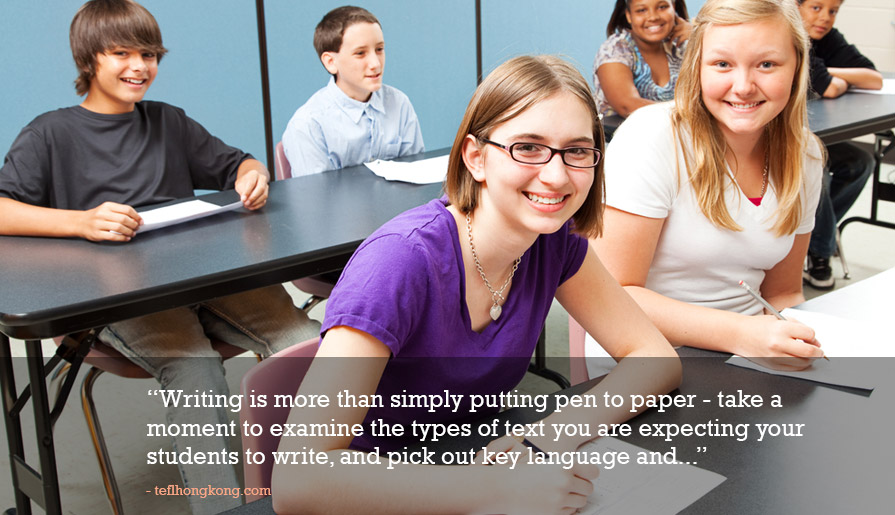
- By: Tom Garside
- In: Teaching Skills
When we consider how we can help our students with writing, there is an important distinction to draw between the ways in which we see this aspect of language use: there is the physical act of putting pen to paper, forming letters and words, which is often referred to as ‘penmanship’.
This is a skill often taught to very young learners at appropriate stages of their physical and linguistic development, or to speakers of languages who do not use the Roman alphabet, and have received little instruction in English-language writing in their compulsory education.
As language educators, however, we can also define writing as a language skill – a communicative act which is linguistic, strategic and cognitive in nature. This article will take writing to mean the latter of these, thinking about the ways we can help our students develop the composition, structures and flow of their writing through analysis of the different types of text we ask them to write.
Genre and appropriacy
Before examining the methodology behind successful writing teaching, it is important to take a step back and look at the nature of written texts in general.
Understanding the nature of different types of text can give us a functional view of written language, which can in turn hep us to define useful features of language to work on with developing writers.
The starting point for this kind of analysis is the notion of genre. A genre of text in any language represents a set of conventions which govern what kind of content and language is to be found in a text of that type, used for its intended purpose.
Any purposeful piece of written language can be categorised into a genre, and analysed accordingly. Let us look at an example of a genre of text: a note to a husband or wife pinned to a fridge with a magnet before leaving for work, although short, informal and dashed off in seconds, represents a genre of text.
We would expect this kind of text to include short, imperative instructions, such as ‘don’t forget to pick up the cake‘, or quick bites of information such as ‘Mum rang – she’s coming at 6‘. Depending on the relationship between the writer and the reader, it might contain a signoff, e.g. ‘see you tonight‘ or ‘love you‘.
Even these simple bits of language have structure and are appropriate to the genre of ‘note on a fridge‘. This is demonstrated further if we imagine a fridge note which said ‘Dear Joan, this is to inform you that I received a phone call from my mother at 7am to inform me that her schedule has changed. She will now be arriving at 6pm, not 7:30, as previously arranged. Kind regards, Bobby.‘ would seem out of place, and is likely to confuse the reader, to say the least. This is because the formal language, extended detail and politeness in this note are not appropriate features for the genre of ‘short note’, but of ‘informative email’, or ‘memo’.
Breaking down these texts further can reveal teachable features in the genres of ‘short note’ and ‘informative email’, which can be used as target language for lessons aiming to develop writing skills with these types of text. Look again at the two example notes above, and identify the following features:
1a) fixed expression for opening
1b) no opening
2a) fixed expression for the signoff
2b) signoff lacks personal pronoun as subject
3a) information assumes reader’s knowledge of topic
3b) information presented in detail as new to the reader
4a) formal word choice
4b) informal / personal word choice
Now match these features with one of the example genres: ‘short note’ or ‘informative email’.
You have just performed a task which is useful for highlighting content and structures in genres of texts to students (though the language in the above task is not graded for use with language learners, as it is intended for readers such as yourselves – as support for learners, the relevant phrases could be highlighted, or collected in a list to match with the functions).
A knowledge of appropriacy and the application of the language expected in certain genres is an important sub-skill in writing.
Ordering information and structuring texts
A next step in such a lesson focus might be to examine the ordering of the content from the first task. What happens first in each example text, then what does the writer communicate? How does this idea develop (if at all), and how does the message end?
Ordering information appropriately is another sub-skill of writing which may seem obvious to those (such as yourselves) with high proficiency in English, but may be dependent on cultural or first-language factors which can cause issues when learners come to write their own texts.
Asking students to write too early, without this kind of preparation, can lead them to produce unstructured or inappropriately organised texts, which, even if otherwise grammatically perfect, can have a negative effect on readers.
What is true for these example genres is also true (if more complex) for academic essays, reports, summary paragraphs etc., and all types of writing which we ask our learners to perform in our classes and for exams.
Look at the genre of texts that you are teaching, and analyse them for structure and content, and you will be able to target specific features in preparatory lesson stages for students to use them in their own writing towards the end of the lesson.
Increasing fluency in genre-based writing
A common issue for learners is that they get halfway into a sentence or paragraph, and then dry up as they don’t know how to continue effectively to complete their idea. Genre-based analysis can help here, too.
Going into your chosen text type more closely, look for grammatical structures and vocabulary groups which are repeated or stand out as important to the completion of ideas. Noticing that passive forms are common in reports and journalistic writing, for example, can prompt you to do some grammar groundwork in that structure before asking students to apply it in one of those genres of writing.
Similarly, the use of reason/result structures in expository writing can point you in the direction of useful phrases to teach before asking students to build their ideas into paragraphs on any topic.
Conclusion:
In summary, remember that writing is more than simply putting pen to paper – take a moment to examine the types of text you are expecting your students to write, and pick out key language and structures which match the genre you are teaching, and their written communication will become more appropriate for the task they are completing.
Further Readings:
- Tips to develop speaking skills
- How to teach your students to listen with purpose
- Develop critical reading skills
This article was published on February 3, 2019.
Courses We Offer:

1. CertTESOL: Certificate in TESOL
A level 5, initial teacher training qualification for new and experienced teachers, enabling you to teach English anywhere in the world. The course is equivalent to Cambridge CELTA.
Learn More
Developed by our Trinity CertTESOL experts, for a comprehensive, self-paced learning experience. Earn an internationally recognized certificate and master essential teaching skills, accessible globally 24/7.
Learn More